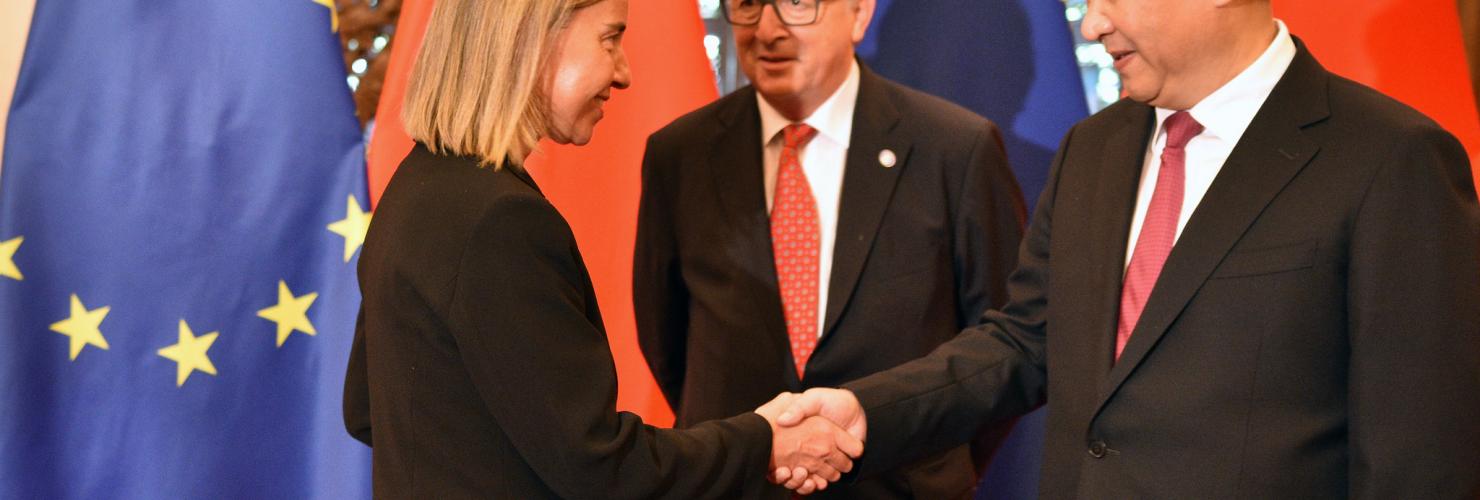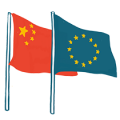

As Europe’s tone on China gets tougher, so does China’s new EU policy
China’s new EU policy paper reflects the assertiveness of Xi’s China and a more nuanced Chinese assessment of EU capabilities. The result is a more strident set of demands for Brussels – and clear evidence European policymakers must be ready for more frictions in interactions with Chinese counterparts in the future.
German industry has surprised Beijing with its call for a stronger EU line on China. But Beijing’s newest EU policy paper – following predecessors in 2003 and 2014 – suggests the hardening of tone is mutual. The new text shows a China empowered and willing to set demands, couched in more abrupt terms than previously. This emerges from the interaction of two phenomena visible in the text: a more assertive China under Xi Jinping; and a more nuanced Chinese assessment of the EU’s capabilities.
The 2018 document reflects Xi’s international ambitions, in tandem with his own supremacy at home. It is the first to mention a Chinese leader by name, with Xi referenced twice, reflecting the dramatic strengthening of his role, not only as “Chairman of Everything” and President-for-Life but also through benediction of Xi Jinping Thought in the state and party constitutions. In the newest EU paper, Xi’s “Thought” is proffered as the guiding spirit in an ideology-focused second paragraph, featuring familiar concepts such as “a new type of international relations” and “a community with a shared future for mankind.” The prominence afforded these ideological totems differs from the earlier papers and underscores the increased importance of ideological work in Xi’s China, refracted in a renewed ideological assertiveness internationally.
Chinese conceptions of the EU have shifted
Comparison of the three documents also marks evolving Chinese conceptions of the EU. The 2003 document came ahead of the EU’s Big Bang enlargement and in the context of Iraq War transatlantic tensions. It captured Beijing’s high hopes for the EU as a fellow pole in a multipolar world, balancing US power. The 2014 follow-up bears the marks of the European financial crisis (as well as Sino-European trade and political tensions – notably over solar panels and the Dalai Lama). Thus, where in 2003 the EU was “a major force in the world” and “highly complementary economically” with China, by 2014 Europe was confronted by its “most serious challenge since … the Cold War” and there was “increasing competition”. In contrast, thanks to “the significant growth of its overall strength”, China was positioned “to provide necessary support” to EU efforts “to achieve financial stability.”
This image of the EU as an incomplete and challenged entity is maintained in 2018, when it is presented as requiring further reform and development. Beijing proposes “win-win” solutions and “coordination of development plans,” echoing language more typically seen in Chinese statements regarding developing countries.
Notably, the 2018 paper is the first to make reference to developing ties with “other European countries” beyond EU institutions and members. On the one hand, this applies to post-Brexit Britain, with which Beijing intends to advance relations “in parallel” with the EU. On the other, it applies to non-EU members of the 16+1 grouping, the Beijing-led sub-regional structure astride the EU’s borders that has rankled with policymakers in Brussels. In the new strategy, the mechanism is defended as “based on common interests” and “open and transparent.” In a post-hoc acceptance of EU access to the structure (first gained by EU officials sneaked in as part of a national delegation), “constructive participation by the EU [is] welcomed.”
Although Chinese leaders have since 2003 managed downwards their expectations for its ability to act as a strong, independent pole in global affairs, the EU remains a priority for Chinese diplomacy. “The two sides [are] indispensable partners to each other’s reform and development.” Like its predecessors, the 2018 paper reflects that “the world is witnessing growing instabilities.” But now the menaces are named: “unilateralism, protectionism and de-globalization.” The name “Trump” is left implicit. As its relations with Washington worsened in 2018, Beijing sought to woo Europe into an anti-Trump axis – captured here in its beseeching Europe to “stick together [with China] in trying times,” and perhaps explaining Beijing’s decision to publish an updated EU policy to undergird a charm offensive.
“The EU should…”: China makes its demands
If this motive would suggest a more charming diplomatic text, such expectations are confounded. The aspirational 2003 text was peppered with activities “China and the EU should” together undertake. In sharp contrast, instead of such collective aspirations, the 2018 paper is punctuated with the more assertive “the EU should…” (appearing only once in the previous texts). The text thus reads as more demanding than its forerunners.
The demand to support China’s stance towards Taiwan is raised more prominently and forcefully than before. Whereas the earlier documents noted that the Taiwan question’s “proper handling is essential for … China-EU relations,” the 2018 language is significantly more strident. Beijing enumerates actions the EU “should” and “should not” take, whereas previously it sufficed to “ask” the EU or note the “importance” of such actions. Strikingly, for the first time the EU is called upon to “explicitly oppose” (明确反对) Taiwanese independence and uphold the One China principle – rather than the EU and its members’ One China policies – “with concrete actions” (实际行动). This matches Beijing’s squeezing of Tsai Ing-wen’s government and the hardening of its tone on Taiwan.
There is indeed a note of warning that the EU should “handle Taiwan-related issues with prudence” (慎重). This laying down of the law is extended to Hong Kong: its “affairs are … China’s internal affairs and should not be interfered in by the EU side.” Since the 2014 Umbrella Movement, China has sought to stymie EU responses to the deteriorating situation in Hong Kong.
Further demands include that the EU “should lift its arms embargo on China at an early date” and “not allow leaders of the Dalai group to visit the EU.” Language on media work is also tightened: “media professionals should observe their professional ethics … and combat fake news and illegal online content.” It is hoped “the EU will play a positive role in facilitating objective, impartial and accurate coverage of China by media” – though censorship is hardly a power granted by the Lisbon Treaty. This echoes China’s broader influencing efforts in Europe.
On the economy and trade, China seeks a “proper reading of … each other’s policies and regulations,” implying it feels misunderstood by rising European frustration at China’s restrictive market. In an apparent effort to allay these concerns, Beijing pledges to “significantly ease market access” – though concrete measures beyond further implementation of its negative list are not outlined. China’s promise to “expand the import of high-quality goods from the EU” is balanced by the demand that “the EU should ease its high-tech export control… [and] strictly fulfil its WTO obligations.” In diplomatic terms, the document implies consternation at the EU’s new investment screening legislation: “China follows with interest EU laws and regulations on trade and investment,” and – perhaps raising eyebrows amongst European businesspeople in China – calls on the EU to “uphold the market order of fair competition.”
China’s more nuanced view of the EU – and its limitations – is not unfounded. And in the 2018 paper it coincides with a Chinese Party-state more willing and able to make demands. While the soothing axiom that “despite differences … China and the EU have no fundamental strategic conflicts” and “share much more common ground than differences” is repeated – and may hold largely true – the reality is that European policy practitioners must prepare to face an increasingly demanding Chinese partner.
